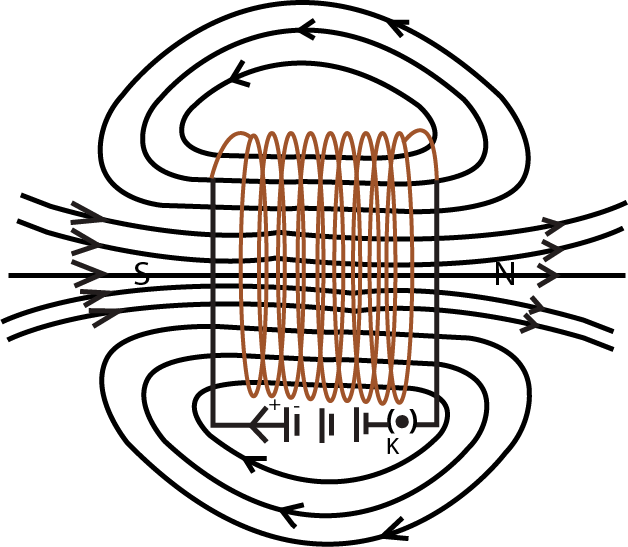CBSE Science Chapter 12 Magnetic Effects Of Electric Current Class 10 Notes: FREE PDF Download
Magnetic Effect Of Electric Current Class 10 Notes: CBSE Science Chapter 12
FAQs on Magnetic Effect Of Electric Current Class 10 Notes: CBSE Science Chapter 12
1. What does Chapter 12 of Class 10 Science depict?
Chapter 12 of Class 10 Science titled Magnetic Effects of Electric Current deals with Magnet and its various properties. Various subtopics covered under this chapter are - Magnetic field, Magnetic field produced by the straight conductor, Magnetic field produced due to circular loop, Magnetic field produced due to a solenoid, Strength of a magnetic field can be changed by, Electromagnet, Kicking wire experiment, Fleming's right-hand rule, Lenz's law, AC generator, Earthing etc.
This chapter includes the definition of the magnet as well i.e. Magnet is such an object which can attract various other objects made out of iron, cobalt, and nickel. Lodestone is a naturally occurring magnet. Magnet is used in various electronic devices: refrigerator, radio and stereo speakers, children’s toys, computer device, and electric wire.
2. What are the properties of the Magnet?
Below are the properties of Magnet.
Each magnet has north and south poles.
Opposite poles attract each other while the same poles repel each other.
A freely suspended magnet will align itself in the north-south direction.
3. What are the benefits of referring to CBSE Class 10 Science Notes Chapter 12 Magnetic Effects of Electric Current offered by Vedantu?
CBSE Class 10 Science Notes Chapter 12 Magnetic Effects of Electric Current offered by Vedantu covers the complete chapter in a comprehensive and thorough manner. So that every student can gain a clear idea about all the points covered under the chapter.
After going through Vedantu’s Magnetic Effect of Electric Current Revision Notes, you will certainly be able to hold a strong command over the topic which is honestly a must thing to pass the Class 10 Science examination with the highest possible grade.
Our in-house experts have specially customized the Magnetic Effects of Electric Current Notes by keeping you and your final exams in mind. These notes are extremely easy to understand, and all your doubts will be clarified after going through the entire notes. However, make sure that you touch the revision notes once you complete the entire Science syllabus. All the important points are formulated in such a way that you will be able to create a strong base for the topic and answer any kind of questions coming your way.
4. How can I download Class 10 Science Revision Notes Chapter 12 from Vedantu website?
You can easily download the revision notes for Magnetic Effect of Electric Current Class 10 PDF from our website. The best part of these revision notes is that these notes are strictly made according to the CBSE marking scheme and guidelines ensuring everything gets thoroughly covered from your end. So, these will boost a lot of confidence.
5. What is the magnetic effect of electric current Class 10 notes?
The topics covered in Class 10 Chapter 12 magnetic effect of electric current are as follows:
Magnetic field and field lines
The magnetic field of current-carrying conductors
Right-hand rule
The magnetic field of current in a circular loop
The magnetic field of current in the solenoid
These topics are covered in detail in the CBSE Class 10 Science Notes provided by Vedantu at free of cost.
6. What are magnetic field lines?
The imaginary lines depicting the magnetic field of a given magnet are referred to as the field lines or the field lines of a magnet. When we let iron fillings settle around bar magnets, they are automatically arranged into a pattern that mimics the field lines of that magnet. Field lines of magnets can also be known with the help of a compass. It is a vector quantity, meaning it has both magnitudes as well as direction.
7. What is a magnet?
A magnet refers to any material that can produce a field that can attract or repel other similar materials that are magnetic in nature.
One such naturally occurring magnet is the Lodestone. This is able to attract materials such as Iron and Nickel.
8. What is the magnetic effect of electric current?
When an electric current is allowed to follow through a given current-carrying conductor, it is capable of producing a magnetic field along with the same. This may be understood through the experiment involving a magnetic needle that can show deflection. The greater the current flow, the higher the deflection will be. When the direction of this current gets reversed, the deflection direction also gets reversed.
9. Explain Fleming’s right-hand rule.
As explained in Fleming’s right-hand rule, when the thumb, index finger and middle finger of one's right hand are stretched to stand perpendicularly to each other, then the thumb will indicate the direction in which the conductor moves, fore-finger will indicate the magnetic field's direction, and the middle finger will indicate the direction of the flow of the induced current. For a more detailed explanation, visit Vedantu.
10. What is the Magnetic Effect of Electric Current?
The Magnetic Effect of Electric Current refers to the phenomenon where a magnetic field is produced around a conductor carrying an electric current. This is the basis for many devices like electric motors and generators.
11. Why are Magnetic Effect of Electric Current Class 10 Notes important?
These notes help students understand key concepts like magnetic fields, electromagnetic induction, and the working principles of devices like motors and transformers, which are crucial for exams.
12. What topics are covered in Class 10 Science Chapter 12 Notes?
The Class 10 Science Chapter 12 Notes cover topics such as magnetic fields, magnetic field lines, Fleming’s Left and Right Hand Rules, electromagnetic induction, and the functioning of electric motors and generators.




















 Watch Video
Watch Video















